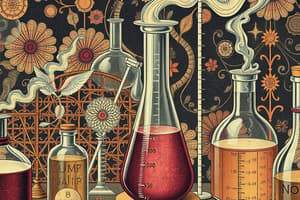Podcast
Questions and Answers
What is the sum of 4.26 and 3.831 reported to the proper number of significant figures?
What is the sum of 4.26 and 3.831 reported to the proper number of significant figures?
- 8.1 (correct)
- 8.09
- 8.09
- 8.0
What result is obtained from the subtraction 8.321 - 2.4 when considering significant figures?
What result is obtained from the subtraction 8.321 - 2.4 when considering significant figures?
- 5.92 (correct)
- 5.9
- 5.921
- 5.92 (correct)
When multiplying numbers, the answer can be no more precise than which of the following?
When multiplying numbers, the answer can be no more precise than which of the following?
- The number with the fewest significant figures (correct)
- The largest number
- The number with the greatest exponent
- The number with the most decimal places
To convert 12 gallons to quarts using the conversion factor 1 gal = 4 qt, what is the correct result?
To convert 12 gallons to quarts using the conversion factor 1 gal = 4 qt, what is the correct result?
How would you express the sum of 0.00000947 and 0.000093 in scientific notation correctly?
How would you express the sum of 0.00000947 and 0.000093 in scientific notation correctly?
Which of the following correctly describes a liquid state of matter?
Which of the following correctly describes a liquid state of matter?
How can matter be classified based on composition?
How can matter be classified based on composition?
Which statement about pure substances is true?
Which statement about pure substances is true?
What distinguishes a mixture from a pure substance?
What distinguishes a mixture from a pure substance?
What defines a homogeneous mixture?
What defines a homogeneous mixture?
Flashcards are hidden until you start studying
Study Notes
Significant Figures and Calculations
- Liters can be reported to the nearest significant figure, for instance, 152.82662 liters rounds to 152.83 liters.
- Addition: Result is determined by the least precise decimal place.
- Subtraction: Similar to addition, significant figures depend on precision of the decimal places.
Scientific Notation
- In scientific notation, solve addition by converting both numbers to standard form.
- Alternatively, adjust one number’s exponent for consistency before adding.
Multiplication and Division of Significant Figures
- Result precision is limited by the number with the fewest significant figures.
- Example: A number with 2 significant figures dictates the answer’s precision.
Unit Conversion
- Factor-Label Method (Dimensional Analysis) aids in unit conversion using conversion factors.
- Example: 1 gallon = 4 quarts allows conversion of 12 gallons to quarts.
Classification of Matter
- Matter can be categorized by state (solid, liquid, gas) and composition (pure substances vs. mixtures).
- Pure substance: One component; Mixture: Combination of two or more components retaining their identities.
States of Matter
- Gas: Particles far apart with no definite shape or volume.
- Liquid: Particles close yet no definite shape, maintains volume.
- Solid: Particles tightly packed, maintains both shape and volume.
Composition of Matter
- Elements: Pure substances that cannot be simplified chemically.
- Compounds: Pure substances formed by the chemical combination of elements in fixed ratios.
Properties and Changes in Matter
- Physical property: Observable without altering substance makeup (e.g., color, hardness).
- Physical change: Alteration in state or appearance without changing composition.
Chemical Properties and Reactions
- Chemical property: Observed only during a chemical reaction.
- Chemical reaction: Transformation into different substances through atomic rearrangement.
Intensive vs. Extensive Properties
- Intensive properties: Independent of quantity (e.g., color, boiling point).
- Extensive properties: Dependent on amount of material present.
Energy
- Defined as the ability to perform work; can be kinetic (energy of motion) or potential (stored energy).
- Energy conversions are less than 100% efficient; reactions involve energy changes.
Units of Energy
- Caloric measurement: 1 calorie = 4.184 joules; food Calories (kcal) measure energy in kilocalories.
Density and Concentration
- Density: Mass-to-volume ratio, used for characterizing substances with unique values.
- Common densities: Water at 1.000 g/mL, Mercury at 13.6 g/mL.
- Concentration reflects the quantity or mass of a substance in a given volume.
Applications of Density
- Calculation of density involves mass and volume; example: Aluminum density calculated as 2.70 g/mL.
- Density can serve as a conversion factor for calculations involving mass and volume.
Example Density Values
- Air: 0.00129 g/mL
- Water: 1.000 g/mL (highest density at 4 degrees C)
- Lead: 11.3 g/mL
- Gasoline: 0.66 to 0.69 g/mL
Temperature Conversions
- Convert between Fahrenheit and Celsius using established formulas.
- Kelvin scale relates directly to molecular motion; important in thermodynamics.
These notes capture essential concepts from chemistry, focusing on measurement accuracy, states of matter, energy forms, properties of substances, and methods for conversion and computation.
Studying That Suits You
Use AI to generate personalized quizzes and flashcards to suit your learning preferences.




